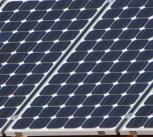
Submitted by Dr Nalin Patel on Wed, 25/03/2015 - 17:47
The causes of a hitherto mysterious process that could enhance the power of solar cells have been explained in a new study
The underlying mechanism behind an enigmatic process called “singlet exciton fission”, which could enable the development of significantly more powerful solar cells, has been identified by scientists in a new study.
The process is only known to happen in certain materials, and occurs when they absorb light. As the light particles come into contact with electrons within the material, the electrons are excited by the light, and the resulting “excited state” splits into two.
If singlet exciton fission can be controlled and incorporated into solar cells, it has the potential to double the amount of electrical current produced from highly energetic blue and green light, capturing a great deal of energy that would normally be wasted as heat and significantly enhancing the efficiency of solar cells as a source of green energy. Until now, however, scientists have not really understood what causes the process, and this has limited their ability to integrate it into solar devices.
Writing in the journal Nature Physics, a team of researchers shows that there is an unexpected link between the splitting process and the vibration of the molecule that occurs when light comes into contact with the electrons. This vibration is thought to drive the production of two excited electrons, revealing for the first time how singlet exciton fission happens.
The work was carried out by a team in Cambridge led by Winton Advanced Research Fellow, Akshay Rao and partners at the University of Oxford. “The picture that emerges is that when they are excited by light, the intrinsic vibrations drive the development of a new electronic state.”
By understanding the fundamentals of singlet exciton fission, the study opens up the possibility of designing new singlet fission materials that would enable the process to be effectively integrated into a new generation of highly efficient solar cells. Future research is already being planned in which the group will examine the precise vibrational states that are required for singlet exciton fission to happen, which will further add to this knowledge.
Further details can be found via this link

